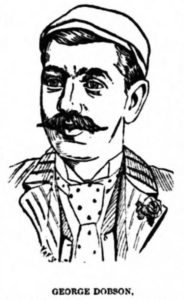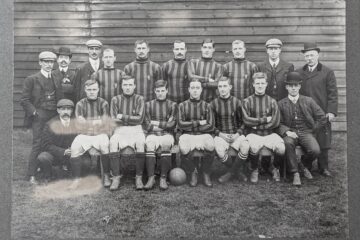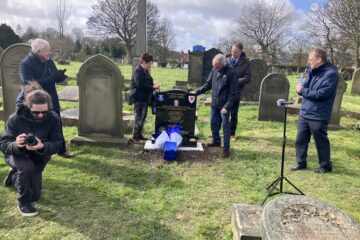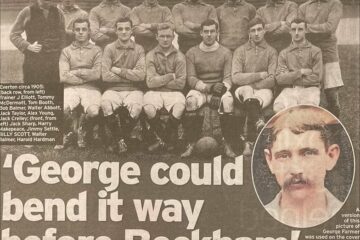The Life and Times of an Everton Goalkeeper
A star of Stanley Park, Priory Road, and Anfield
It was the winter of 1880, and the football players of Everton were trooping off their pitch on Stanley Park having just been soundly beaten by the parishioners of St John’s Church in Bootle. Later that year they were approached by a young Scotsman who, having just moved to the area, asked them if he might be allowed to join them in their ‘kick about’ matches on the park. The Everton players agreed and welcomed him into the fold. The new arrival immediately began to demonstrate his considerable football skills to the Everton players, who quickly offered him the dual role of club captain and coach. The newcomer’s name was Jack McGill.

The newspapers of the time state that McGill was an ex-Rangers player, while John Keats, the famous Everton historian, tells us he was born in Ayrshire. These statements, however, are not correct. John McGill, which was his given name, first saw the light of day on 25 February 1859, up a close of number 559 tenement on the lengthy Gallowgate thoroughfare in Glasgow. Between then and his coming to Liverpool, there is no record of him having ever played football for either the first or second teams of Rangers Football Club.
The 1881 census records him as a skilled engineer living with his sister Hannah, and his young nephew, at 18 York Terrace in Everton. The house was owned by his brother-in-law, John Montieth, who was a sea-going engineer, sailing out of Liverpool aboard the SS Palm. He was absent on the night that the census was taken, so Hannah McGill is listed as ‘Head of the Household.’
‘Jack’ McGill, as he was more commonly known, made his Everton debut on 9 October 1880, against a side who called themselves the Liverpool Association. The match took place on Newsham Park, and he scored in a 3-1 victory. He made his Stanley Park debut on 30 October 1880, but could not prevent his side from losing by two goals to one against the second string of players who represented Darwen Football Club. This was the season that Everton first entered a knockout tournament, the Lancashire Cup, but they fell at the first hurdle to a very experienced side from the Great Lever area of Bolton. However, Jack McGill went on to lead his team to victory throughout the rest of the season and scored thirteen goals in the process.
Under McGill’s leadership, Everton made a slight improvement in the course of the next season which saw them exit the Lancashire knockout in December, at Turton. Nevertheless, his talent had not gone unnoticed by the Lancashire FA Committee who selected Jack to represent the Red Rose County in match against a team of players from the North Wales FA. On 14 January 1882, he scored all his team’s goals as they defeated a full-strength Bootle eleven at their Marsh Lane ground by four goals to one. Everton went on to suffer just one defeat, away at Oswestry, as Jack ended the campaign with twenty-three goals to his credit.
The following season, 1882-83, saw the formation of the Liverpool & District FA who declared that they, too, would organise a knockout competition for their membership. In the meantime, Everton had to concentrate on the Lancashire knockout, where the draw had given them an away tie against the firm favourites to lift the trophy, Blackburn Rovers. The gulf between the two clubs was to prove enormous.
The match took place at the home of Blackburn Rovers at the time which was known as the Leamington Ground. It was played on a Monday afternoon. The visitors arrived to find the ground was an enclosure and was entered via a strong, iron gate. On each side of the gate were four smaller points of access for paying customers which had been fitted with turnstiles. The location had a brick building on each side of the entrance . The one on the left served as a refreshment room while the building on the right, complete with hot running water, contained two dressing rooms. The playing area was completely fenced off and wooden duckboards lay all round it. The main feature of the location was a well-constructed, covered grandstand that could seat over 500 people. The Leamington Ground was a far cry from the open windswept home of the visitors at Stanley Park.
Jack McGill would have been warmly greeted, no doubt, by the several Scottish players in a home side that was captained by his fellow Glaswegian, Hugh McIntyre. Any welcome was to be sort-lived, however. Urged on by a crowd of around 700 spectators, Blackburn Rovers set about giving the amateurs from Merseyside a football lesson. They scored four goals each side of half-time to win the game by eight goals to nil. A local journalist watching the match commented that:
as the game progressed it was seen that, although exceeding sharp players, the visitors were a little impetuous and rather carless with regard to observing their respective positions. For some time getting the ball simply appeared to be the entire object of their endeavours (Blackburn Standard, 7 October 1882.)
Also in the crowd that day was a certain Sam Ormerod. He was a prominent member of the Lancashire FA Committee and strongly connected to Accrington Football Club. When the game was over, he approached Jack McGill and asked him if he would like to play for Accrington on their enclosed home at Thornyholme Cricket Ground. The Scotsman accepted. (Although it was never mentioned, it is likely that when Jack had a game for Accrington, he would quite possibly have found a pound note or two tucked inside his jacket).
Jack McGill then spent three months playing for the East Lancashire club before returning to help Everton in their quest to win the Liverpool Cup. They reached the semi-final, but were beaten three goals to one by a Bootle side who had imported three guest players for the occasion. On 14 April 1883, Jack McGill scored the equalising goal for Everton in a 1-1 draw with Turton, in what turned out to be their final game on Stanley Park, before the move over to the enclosure on Priory Road.
The new venue opened with game between the new Liverpool FA and a side who represented their counterparts in Walsall. The home forward line was led by Jack McGill and the game ended in a 1-1 draw. The new venture nearly spelt disaster for Everton because they could not induce the leading football clubs, such as Blackburn Rovers and Bolton Wanderers, to visit the location. The public were not prepared to pay and watch teams like Hartford St Johns and Ormskirk because they were no better than the teams who were still playing on Stanley Park.
The visit of Crewe Alexandra drew a gate of around 500 to see Jack McGill, who was injured at the time, take over the goalkeeping duties for Everton. However, the local knockout was to prove a blessing for Everton, as both St Peters and Bootle Wanderers, having been granted a home draw, elected to transfer their matches to the Priory Road enclosure. In the course of the tournament, Jack scored five goals which helped his club to reach the final where a game against Earlestown awaited them. The match drew a crowd of 2,500 to the Bootle Cricket Ground to watch McGill lead his side to 1-0 victory.
In the course of the season, only nine matches had been played at Priory Road and very little money was taken at the gate. The club soon found themselves with a debt to their landlord that had to be paid off by two members of the committee before the club moved over to Anfield Road.
Everton began their eight-year tenure at this location with a home game against Earlestown. The club had no recognised right-back so Jack McGill, the only man capable of filling the vacancy, began the season in this position. He was later switched to half-back before returning to the forward line. Blackburn Rovers and Bolton Wanderers finally consented to visit the venue, but both fulfilled their fixtures with sides that consisted mostly of second team players. Jack again led his side through to the final of the Liverpool Cup where the opposition was once more provided by Earlestown. The popularity of the game had now increased on Merseyside, and this resulted in over 5,000 paying spectators. When trailing 1-0, Everton thought they had equalised but to their annoyance, the goal was disallowed by the referee.
 Easter time then saw George Dobson and George Farmer join Everton and they played alongside McGill until the end of the season. Both players returned next season and Dobson was appointed to the role of club captain. Everton began their list of fixtures with a home game against a Burnley side who were visiting Anfield for the first time. The club were missing a left winger so McGill was pressed into this position. Job Wilding was then signed from Wrexham and the goalscoring duties were entrusted to him. As a result, Jack McGill took up his position in the second eleven from where, eventually, he retired from the game. He did, however, maintain close links with Everton and was often observed watching the game at Anfield and Goodison Park.
Easter time then saw George Dobson and George Farmer join Everton and they played alongside McGill until the end of the season. Both players returned next season and Dobson was appointed to the role of club captain. Everton began their list of fixtures with a home game against a Burnley side who were visiting Anfield for the first time. The club were missing a left winger so McGill was pressed into this position. Job Wilding was then signed from Wrexham and the goalscoring duties were entrusted to him. As a result, Jack McGill took up his position in the second eleven from where, eventually, he retired from the game. He did, however, maintain close links with Everton and was often observed watching the game at Anfield and Goodison Park.
Jack McGill was living on Havelock Street when he succumbed to charms of a local, 21-year-old, widowed lass named Mary Ellen Powdrell. The couple were married 5 January 1887 at the parish church of St Peter, before setting up home in Everton at 21 Rydal Street. Jack continued working in the engineering trade, while Mary remained at home to look after their three daughters. The McGill family later moved to Kempston Road, Wavertree, were they lived until Jack’s death.
John McGill, the first Scot to play for Everton, died on 17 January 1937, and was buried in Toxteth cemetery on Smithdown Road. He was survived by his wife and three children.



